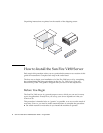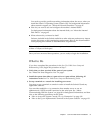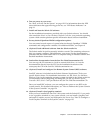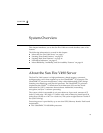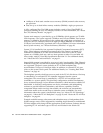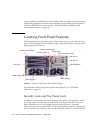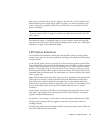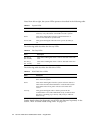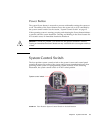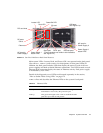
10 Sun Fire V490 Server Administration Guide • August 2004
■ 16 Mbytes of local static random access memory (SRAM) external cache memory
per processor
■ Slots for up to 16 dual inline memory modules (DIMMs)—eight per processor
A fully configured Sun Fire V490 system includes a total of four UltraSPARC IV
processors residing on two CPU/Memory boards. For more information, see “About
the CPU/Memory Boards” on page 27.
System main memory is provided by up to 32 DIMMs, which operate at a 75-MHz
clock frequency. The system supports 512-Mbyte and 1-Gbyte DIMMs. Total system
memory is shared by all processors in the system and ranges from a minimum of
8 Gbytes (one CPU/Memory board with eight 512-Mbyte DIMMs) to a maximum of
32 Gbytes (two boards fully populated with 1-Gbyte DIMMs). For more information
about system memory, see “About the Memory Modules” on page 28.
System I/O is handled by four separate Peripheral Component Interconnect (PCI)
buses. These industry-standard buses support all of the system’s on-board I/O
controllers in addition to six slots for PCI interface cards. Four of the PCI slots
operate at a 33-MHz clock rate, and two slots operate at either 33 or 66 MHz. All
slots comply with PCI Local Bus Specification Revision 2.1. For additional details,
see “About the PCI Cards and Buses” on page 31.
Internal disk storage is provided by up to two 1-inch, hot-pluggable, Fibre Channel-
Arbitrated Loop (FC-AL) disk drives. Both single-loop and dual-loop configurations
are supported. The basic system includes an FC-AL disk backplane that
accommodates 73-Gbyte or 146-Gbyte disks. In addition, an external FC-AL port
exists on the system’s back panel. For additional details, see “Locating Back Panel
Features” on page 16.
The backplane provides dual-loop access to each of the FC-AL disk drives. One loop
is controlled by an on-board FC-AL controller integrated into the system
centerplane. The second loop is controlled by a PCI FC-AL host adapter card
(available as a system option). This dual-loop configuration enables simultaneous
access to internal storage via two different controllers, which increases available I/O
bandwidth. A dual-loop configuration can also be combined with multipathing
software to provide hardware redundancy and failover capability. Should a
component failure render one loop inaccessible, the software can automatically
switch data traffic to the second loop to maintain system availability. For more
information about the system’s internal disk array, see “About FC-AL Technology”
on page 41, “About the FC-AL Backplane” on page 43, and “About the FC-AL Host
Adapters” on page 44.
External multidisk storage subsystems and redundant array of independent disks
(RAID) storage arrays can be supported by installing single-channel or multichannel
PCI host adapter cards along with the appropriate system software. Software drivers
supporting FC-AL and other types of devices are included in the Solaris OS.



